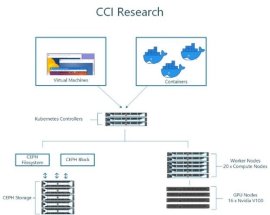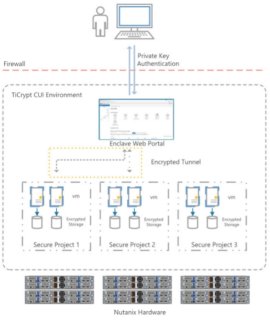Request HPC Resources
Faculty, staff and students at ODU can request access to HPC resources. Anyone outside ODU who collaborates with ODU researchers can also request access with signoff by an ODU researcher. For further information, contact itshelp@odu.edu.
Wahab Cluster
wahab.hpc.odu.edu
Funded through a grant from the National Science Foundation's Major Research Instrumentation Program, the Wahab cluster offers substantial computational power to critical research projects in disciplines including cybersecurity, resilience and data-intensive science and engineering. The system's speed and power make it possible to compute and analyze enormous amounts of data related to sea-level rise, natural disasters, brain imaging, cyberattack paths, and so much more.
The Wahab Research Environment is configured with 6320 computational cores and 72 NVidia V100 GPUs, with 158 compute nodes and 18 GPU nodes. Each compute node contains 40 cores at 2.4Gh and 368Gb RAM. All nodes are connected via a Mellanox Infiniband EDR backbone providing 100Gbps throughput. The GPU nodes each contain four NVidia V100 GPUs, and each V100 contains 640 tensor cores to facilitate deep learning research.
The cluster is open to all campus researchers and will serve the research computing needs of the students and faculty at ODU for years to come.
The Wahab cluster is supported in part by National Science Foundation's grant CNS-1828593, "MRI Acquisition: A Reconfigurable Computing Infrastructure Enabling Interdisciplinary and Collaborative Research in Hampton Roads".
Cluster Hardware Types
| Node Type | Info | Node Name Prefix |
| Standard Compute |
158 Nodes Available 40 Slots (Cores) per Node (max) 368GB RAM per Node |
d1-6420a-### d4-6420b-### d5-6420b-### d6-6420b-### |
| GPU |
18 Nodes Available 32 Slots (Cores) per Node (max) Nvidia V100 192GB RAM per Node |
d2-w4140a-### d3-w4140b-### d4-w4140b-### |
File Storage Locations
| Path | Description | Network Connection | Backup Status |
| /scratch | Working data area | LUSTRE | NO |
| /home | User home directories | NFS | YES |
| /RC/home | Per User Research storage directories | NFS | YES |
| /RC/group | Per Group Research storage directories | NFS | YES |
Turing Cluster
turing.hpc.odu.edu
The Turing cluster contains 258 multi-core compute nodes, each containing between 16 and 32 cores and 128 GB of RAM. The cluster also provides 7 high memory nodes containing between 512 and 768 GB of RAM, 21 GPU nodes each with one or more NVIDIA GPU's and 10 Intel Xeon Phi nodes each with 2 Xeon Phi MIC cards. An FDR inifiniband network provides fast cluster communication. The cluster is highly redundant with clustered head nodes and a dedicated login node. Users connect to the login node over aggregated 10 Gb connections.
The Turing cluster supports a variety of research including fluid dynamics, genomics, molecular dynamics and oceanographic research.
Cluster Hardware Types
| Node Type | Info | Node Name Prefix |
| Standard Compute |
220 Nodes Available 16-32 Slots (Cores) per Node (max) 128GB RAM per Node |
coreV1-##-### corev2-##-### coreV3-##-### coreV4-##-### |
| GPU |
21 Nodes Available 28-32 Slots (Cores) per Node (max) Nvidia K40, K80, P100, V100 GPU(s) 128GB RAM per Node |
coreV3-23-k40-### coreV4-21-k80-### coreV4-22-p100-### coreV4-24-v100-### |
| Xeon Phi |
10 Nodes Available 20 Slots (Cores) per Node (max) Intel 2250 Phi MICs 128GB RAM per Node |
coreV2-25-knc-### |
| High Memory |
7 Nodes Available 32 Slots (Cores) per Node (max) 512-768GB RAM per Node |
coreV2-23-himem-### |
File Storage Locations
| Path | Description | Network Connection | Backup Status |
| /home | User home directories | NFS | YES |
| /RC/home | Per User Research storage directories | NFS | YES |
| /RC/group | Per Group Research storage directories | NFS | YES |
| /scratch-lustre | Working data area | LUSTRE | NO |
Hadoop Cluster
The hadoop cluster is made up of a resource manager, name node and 6 data nodes. The cluster has the following hardware resources available:
The HDFS file system comprises 7.71TB of total storage. The data nodes are connected over an FDR infiniband network for high speed internode communication and the name node and resource manager are connected via 10GB interfaces.
The name node handles the management of the HDFS file system while the resource manager schedules jobs on the data nodes.
Cluster Hardware Resources
| Node Type | Info | Node Name Prefix |
| Resource Manager | 1 Node Available | |
| Name Node | 1 Node Available | |
| Data Node |
6 Nodes Available 128GB RAM 3 x 400GB SSD Storage |
CCI-R Environment
COVA CCI is southeastern Virginia's engine for research, innovation, and commercialization of next-generation cybersecurity technologies particularly in the areas of Cyber Physical Systems Security (CPSS), 5G, and Artificial Intelligence (AI) in the Maritime, Defense, and Transportation industries.
CCI Research Overview
The COVA CCI research environment is focused on advancing research in the coastal Virginia region. It consists of a private cloud with the ability to host research applications customized to specific research needs.
The advantages of using the research cloud over your typical workstation include:
- Designed for research involving sensitive data types
- Access to large compute capacity
- Access to GPU's for intense machine learning workflows
- Enterprise grade hardware and software for reliability
- Located in enterprise data center to provide cushion for cooling and power issues.
- Support for a variety of workloads including container orchestration and virtual machines
Cluster Hardware Types
| Node Type | Info |
| Standard Compute | 20 Nodes Available |
| GPU |
4 Nodes Available 52 Cores 192GB RAM 16 Nvidia V100 GPU's |
RRCE Environment
The Regulated Research Computational Environment (RRCE) is built through a partnership between ODU, EVMS and Sentara. It provides a virtual lab environment for computation and storage of regulated data sets including CUI and HIPAA. Capabilities range from high-capacity storage to cutting edge GPUs to accelerate AI/ML research, data science and HPC. The environment is built on the TiCrypt software and provides a secure interface to transfer data and manage research projects in multiple security enclaves with disparate regulatory requirements.
Features of RRCE
- High-speed connectivity between ODU, VMASC and EVMS
- Hyperconverged virtual environment
- 240 computation cores
- 12 Nvidia A100 GPUs
- Secure, segmented network infrastructure
- NIST 800-171, and CMMC level 2 compliance
Types of protected data
- General sensitive data (ex: business confidential)
- Regulated sensitive data:
- FERPA (educational data, e.g. student records)
- Personal Health Information (regulated by HIPAA)
- Controlled Unclassified Information (CUI, NIST 800-171)
- ITAR data (export-controlled data)
Features
- Linux and Windows virtual machines built on demand from golden images
- Persistent, encrypted data storage and sharing via tiCrypt's Vault and Drives
- Audit logging and alerting
- Data labeling for security classification
- Secure data ingestion via forms and sftp
Research Software
The software packages installed on the compute clusters is continuously changing with researchers needs.
Open Source Packages
- Physics/chemistry: Espresso, gromacs
- Biology: BLAST, Bioperl, migrate-n
- Engineering: OpenFOAM
- Statistics/math: R, Pandas, octave
- Scripting: python, perl, ruby, Java, ROOT
- Visualization: VTK, ParaView
Commercial Packages
- Chemistry: Gaussian, Molpro, VASP, amber
- Math: MATLAB
- Biology: CLC Bio
- Engineering/physics: COMSOL, ANSYS
- Statistics/business: SAS
Software Development Tools & Libraries
- Compilers: Intel, PGI, GNU (Fortran, C, C++), Clang, NVIDIA (CUDA)
- Libraries: math (MKL, LAPACK, fftw3), machine learning (TensorFlow, PyTorch, Caffe, scikit-learn)
- Parallel programming (MPI, Charm++)
- Debuggers, profilers (GDB, TotalView, PAPI)
These are representative lists only. The complete list is much longer and keeps growing!
If there is software you need to use that is not on this list please contact us and we will install it for you.
Software Download
Login Tools
Windows:
- Putty is a lightweight ssh client used for command line access to the clusters.
- RDP is recommended for graphical access to cluster resources.
Mac/Linux:
- Mac and Linux systems typically have an ssh client built in. You can also download the Microsoft RDP client for graphical access.
File Transfer Tools
We recommend FileZilla to transfer files to and from the cluster. It's easy to use and works across multiple platforms. After you download and install the application, it needs to be configured to connect to the cluster (either Turing or Wahab).





